Design of rooms in the same style. How to keep the interior in the same style
When a person without a professional base begins to think about his future interior, he usually just gets lost. Great amount beautiful interiors, I like everything, it’s difficult to stop at something. Stepan Bugaev, art director of the Pobeda Design architectural bureau, shares his advice.
- 1 of 1
On the picture:
Deciding on style
The main problem when choosing the style of the future interior, there is a glut of information. A specialist can distinguish features with the naked eye various styles. There are independent mixed styles in interiors, such as eclecticism and kitsch. But they are also based on certain canons, this is by no means a thoughtless combination of details, they are based on the rules of artistic and aesthetic perception. So the people who just mixed different styles in their interior and say that the design of their apartment is made in the style of eclecticism or kitsch, they make a big mistake.
In order for your the interior was harmonious and solid, you should decide which style is your priority. Look distinctive features of this style, to study the aesthetic component and the philosophy of perception. Any styles in the interiors should not be taken head-on. So eco-style is not just a combination of wooden snags in the interior, but a philosophy of use natural materials and natural elements. Minimalism is not just a style with straight forms and no decor, but a philosophy of free light space and laconic forms.
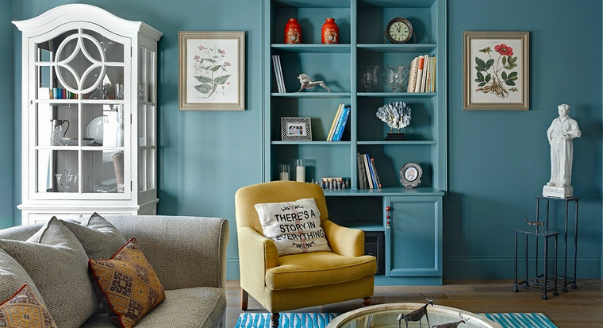
- 1 of 3
On the picture:
Professional designers know the characteristic features of all styles and can combine them skillfully and in a balanced way.
Let's mix paints
Pure apartment design styles it is almost impossible to meet, our time implies a mixture of directions. Therefore, we advise you to take one style as a basis and add elements of other styles to it. So you get a single concept with the addition of various motives. A balanced combination can be achieved by using equal proportions of additional topics. But you shouldn’t get carried away with this either, it’s enough to add one or two additional topics to the main direction. If you create an interior without the help of professionals, you should not use incompatible directions: high-tech and Provence, Japanese style and Art Deco, 1950s-60s style and Art Nouveau.
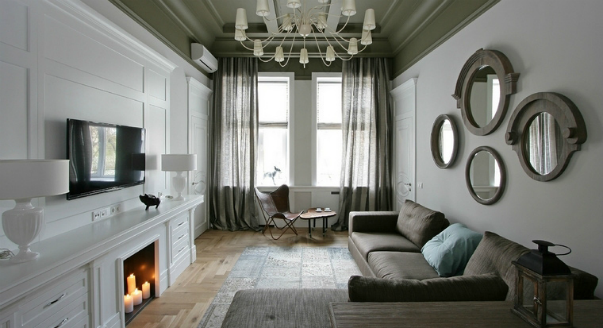
- 1 of 3
On the picture:
It is important not to overload the interior with objects of complex shapes.
To create an interior uniform style we recommend using the following methods.
1. As we said above, choose one foundational style.
2. Select the main color scheme. It can be several different options:
- one main color with the addition of elements of other colors
- pastel scale
- different shades one color.
3. In finishing materials it is better to use textures that combine with each other, which will be in harmony with both the chosen style and the chosen color scheme.

- 1 of 4
On the picture:
We tried to highlight a few points that may seem categorical, but this is precisely the most correct and simple way to create a single harmonious interior. Professional designer can make eclecticism and kitsch a single style, but do not overestimate your strengths. If you decide to choose only one style for yourself, without adding other topics, do not think that it is impossible to make a mistake within one style. "Pure" styles are a thing of the past, so don't get too carried away characteristic features one style, otherwise the interior will look oppressive and overloaded.
4. The style of furniture should also be in line with the chosen concept. Most manufacturers divide furniture into two areas: modern and classic. Furniture of simple shapes is suitable for modern styles: minimalism, high-tech, Japanese, Scandinavian. classic furniture can be used for the following areas: classic, art deco, art nouveau, provence.
5. Lighting is selected according to the same principle as furniture. To achieve harmony in the interior, you can use the built-in lighting. This is an absolutely neutral type of lighting, to which you can add one chandelier or floor lamp of your chosen style as an accent.
6. Do not get carried away with decor. The decor carries a strong stylistic focus and can break the overall concept of the interior.
Comment on FB Comment on VK
In a single vein, or is it better to choose your own style for each room, each room?
I must say right away: in our typical apartments, sharp stylistic contrasts look bad. Now, if you were the owner of a family castle with spacious passages from one wing to another, or would have at least a two-story country cottage– then another matter.
In this case, different styling rooms would look quite acceptable. And in our small typical apartments, it’s better to strive to ensure that when moving from one room to another, the eyes do not run up and the eyes do not get tired of excessive contrasts.
When each room in a small apartment is decorated differently, it turns out to be inconsistent, and this always indicates a lack of taste among the owners.
Therefore, if we are talking about a typical two-three-room apartment, then I advocate a single style for all its premises. Thanks to this, the space of the apartment becomes single, integral, and not fragmented.
In the West, for example, where much more attention is paid to interior design than ours, the same finish is often used for all rooms in an apartment. In particular, all the walls and ceiling of the apartment are usually painted in White color, while the floor is made light gray or light brown.
This approach visually enlarges the dwelling, makes it complete. The walls seem to be moving apart, and the boundaries between individual rooms are blurred.
For clarity, I will give two examples. First, let's go to one of the apartments. Imagine that the walls of all the rooms of this apartment, as well as the hallway, are covered with the same pale green wallpaper, and the floor is light brown parquet. The kitchen and bathroom are tiled with light green tiles. The floor of these rooms is tiled with light brown tiles. Remember the feeling of this apartment.
Now let's mentally move to another dwelling. Everything is set up differently there. A large room kept in a classic style. She's papered over beige wallpaper with floral pattern plus dark brown parquet.
The small room resembles a boudoir: it is covered with pink wallpaper in white stripes, and on the floor - a dark pink carpet. The style of the hallway is strict, cabinet, it is lined with wall panels under the tree.
The kitchen is decorated in the spirit country house: its walls are sheathed with wooden slats, and on the floor lies linoleum with a pattern that imitates pine boards. The bathroom is tiled in turquoise, while the toilet is white and blue, while the floor in these rooms is lined with black tiles.
Isn't it enough to enumerate already, because the variety of this finish ripples in the eyes? Sometimes from the contemplation of such dwellings, a feeling of merchant bad taste can arise.
So, I hope you get the point I'm trying to make. The desire for diversity is, of course, not bad. But it must have its limits, especially small apartments. Therefore, do not be afraid to finish all the premises of your apartment in the same way.
And do not be afraid that monotony and monotony may arise in this case. After all, you can always spice up every room by decorating it in your own way.
If you are still afraid that with the same design the apartment will look boring, then in this case, so be it, combine different styles with each other. But under one indispensable condition: they must be related to each other.
So, for example, the following styles are well combined with each other: classic, antique and retro. You can also get excellent result, combining with each other such styles as minimalism and hi-tech.
Home decorating is one of the oldest human activities. We spend a lot of time in the house, so the convenience, atmosphere and overall feeling of the interior is important for our sense of self. Today, the planning and interior of a residential building is the sphere of work of specially trained people: designers, architects, decorators. Let's talk about the principles on which the interior is built, what styles of decoration exist.
Interior concept
The literal translation of the word "interior" from French means "internal". This concept today includes not only decoration, but also planning, zoning, development comfortable arrangement furniture and objects in accordance with human behavioral scenarios. When the need arises to create the interior of a residential building, the first thing that comes to mind is to turn to specialists. Designers, decorators, sometimes architects are engaged in the design of living space. But still, more often people are engaged in decorating their home on their own, listening a little to the advice of professionals. Therefore, it often comes down to choosing the color of the walls. And the interior is a well-thought-out organization of living space, which should contribute to the normal functioning of a person.
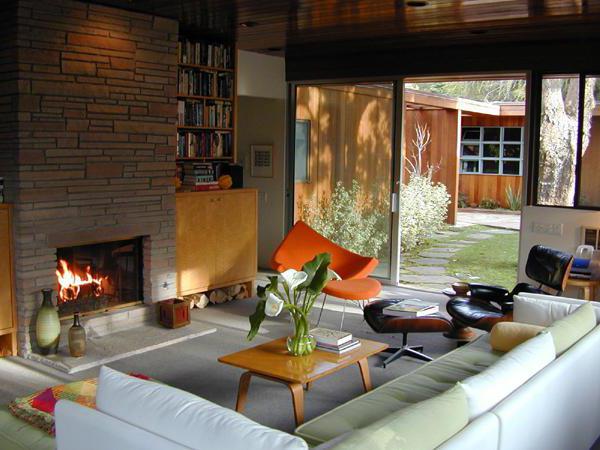
Interior planning principles
When creating the interior of a residential building, you should remember about basic principles design and layout. First of all, the room must meet the requirements of ergonomics and anthropometry. That is, it should fit a person in size, allowing him to engage in familiar activities without spending extra resources and without experiencing discomfort. Also, any design rests "on three pillars": benefit, function and beauty. For long history there have been periods when beauty was the main focus, for example, in the Baroque era, or only functionality, for example, in the minimalist style. But modern man strives for a balance of aesthetics and practicality, and also strives to comply with the rule of environmental friendliness. A competent residential building often mentions the main compositional principles that must be taken into account when decorating a home. This is integrity, harmony, balance, the presence of a compositional center, accents and rhythm. Any interior consists of three groups of elements: building shell, i.e. walls, floor, ceiling, windows; items, i.e. furniture, equipment; functional processes, i.e. everything that allows a person to do indoors necessary actions and also shapes emotions and atmosphere.
Zoning of the premises
When designing a living space, it is necessary to think over at the design stage functional areas. It is based on three principles:
Age. Separate spaces are necessary for different generations of residents.
Temporal. Traditionally, night and daytime activities are separated.
Functional. The room must meet the individual needs and lifestyle of all family members.
Should be determined before starting work on the decor. You should carefully consider places to sleep, highlight public and business areas, consider the placement of communications and technical equipment.
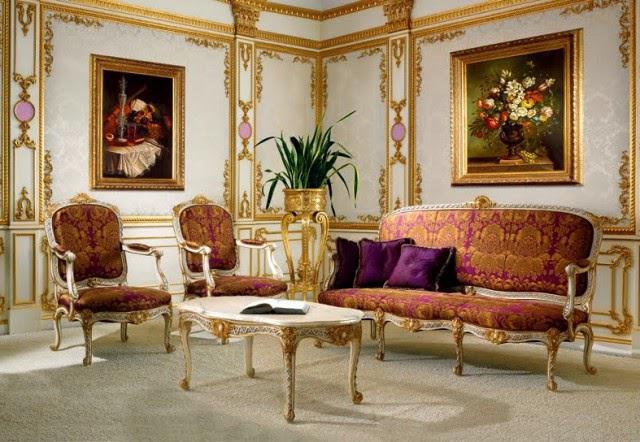
Light in the house
Man is a solar being, and his mood and well-being depend on the illumination of the dwelling, this should be remembered when creating the interior of a residential building. Lighting can be natural or artificial. In the first case, we are talking about windows. If possible, it is better to choose dwellings with windows facing the different sides, and it is desirable that the openings be large enough. But in any case, it will not be possible to do without artificial lighting. When planning it, you need to think over various lighting scenarios that will help residents live and act comfortably. Traditionally, there is general, functional and accent lighting. The purpose of the general light in the room is to maintain a sufficient level of illumination. Traditionally, its sources are located on the ceiling, it can be central chandelier or several lamps around the perimeter of the ceiling. Today, in modern interiors, designers are increasingly abandoning the central lamp, and prefer several lamps that maintain the overall level of illumination. Functional light sources are installed above the areas where residents will perform some kind of activity: read, cook, work. In such places, table or pendant lamps, sconces, floor lamps are usually installed, preferably with the ability to change the angle of incidence of the beam. Accent light is designed to highlight some of its elements in the interior, for example, paintings. For this, small lamps and spots are used.
![]()
Plants in the interior of a residential building. Selection rules, preferences
An important role is played by plants in the interior of a residential building. They create comfort, "enliven" the room, purify the air, fill it with phytoncides, and can also zone it. However, it is worth remembering a few simple rules. The plant should harmoniously fit into the room in size, it should not capture the entire place, although it can act as an accent. Carefully live plants should be placed in bedrooms and children's rooms, remembering that at night they absorb oxygen. It is also worth remembering that the flora requires care, and if the owners are not ready for this, then artificial copies can be dispensed with.
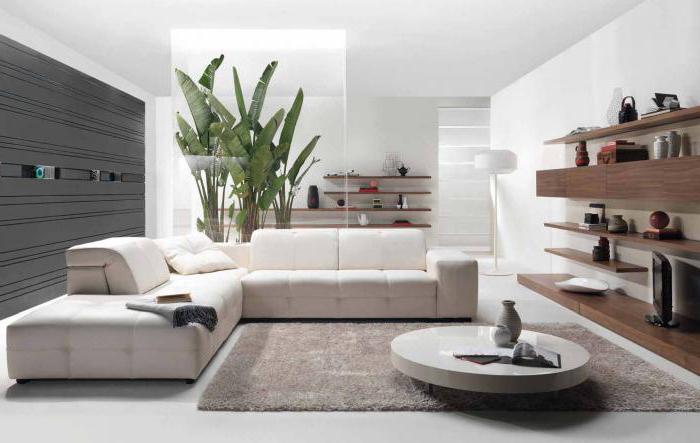
Furniture arrangement
Any kind of interior of a residential building is impossible without furniture. When planning a home, you need to consider the arrangement of items in accordance with zoning and the needs of people. The aesthetic factor also plays an important role. The usual way of distributing furniture along the walls is not always convenient and productive. With the help of furniture, you can adjust the shape of the room, which, ideally, should be brought to a square. The main placement rules are as follows:
It is necessary to observe the proportionality and proportionality of objects;
Between objects in the room there should be enough space for transit, comfortable access should be provided to cabinets and shelves;
It is worth choosing the main object, for example, a sofa, a fireplace or a table, and build the composition of the room around it. Do not be afraid to bring the object to the middle of the room, because the complication of the movement route can create new scenarios for using the room. Before arranging furniture, you need to carefully analyze the lifestyle of its owners and provide for all possible options actions to calculate the space for each feature.
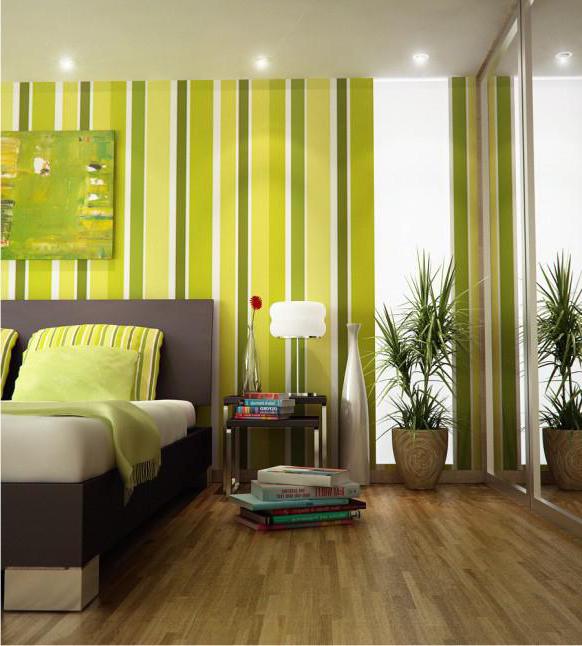
Color in the interior
When creating a project on the theme "Interior of a residential building", you need to make important decisions about the color content of the room. Psychologists have proven that color has a great influence on the mood and well-being of a person, this must be taken into account when choosing color options for an apartment. It is also worth remembering that a person will spend a lot of time in these rooms, and nothing should annoy or oppress him. There is a rule that it is not recommended to use more than 3 colors in one room. 60% of surfaces should be painted in the main color, most often in a discreet and neutral one. 30% of the surfaces are made in the second color, it should be in harmony with the main one, but differ significantly from it. The easiest way is to choose two tones that are adjacent in color wheel. 10% of the room is decorated with a contrasting color scheme in relation to the second. For example, curtains in the interior of a residential building can be a bright accent, and large decor items can also perform the same functions.
Interior style
Today, designers use a variety of residential buildings. Choosing it, it is worth evaluating the possibilities of the room. So, a large bright room is ideal for classical style, and a small area can be enlarged using the possibilities of hi-tech or minimalism. Also, the choice of style, of course, is influenced by the personal preferences of the owners, the climate outside the window, the overall design concept and even fashion. When decorating the interior, you should not always strive to create a perfect stylization, after all, the house should reflect the individuality of the owners. In addition, today not exact stylizations are relevant, but nuanced interiors, with slight hints of some kind of style. Eclectic is here main style that dominates the 21st century.
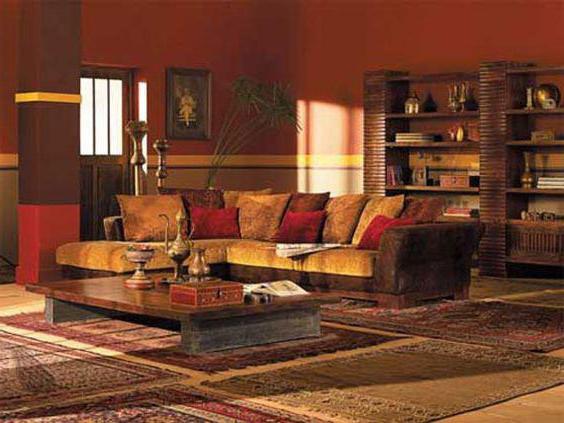
Classic
The most popular style in which the interior of a residential building is decorated is a classic. Its signs are the attraction to light colors and traditional materials: wood, stone. Classic interiors are built according to the principles of symmetry, with a clear selection of the compositional center. Usually, an invisible axis passes through the center of the room, relative to which a harmonious symmetrical composition. This style is characterized by the use of such elements as stucco, semi-columns, pilasters, rosettes, expensive fabrics, furniture made of solid wood, parquet. Classics are usually characterized by the use of a large number decorative elements: vases, paintings, sofa cushions, candlesticks, lamps. The classic suggests central lighting in the form of a chandelier, most often crystal, and several additional light sources.
historicism
Classical styles in the interior of a residential building are divided into several eras, referred to as " big styles". These are classicism, baroque, rococo and empire. The most luxurious and pretentious is the baroque, we can see it in the royal palaces of Louis the Fourteenth. He is characterized by the use of a large number of carved, gilded details, velvet in upholstery and curtains, and paintings. The more restrained and refined Rococo, characteristic of the time of Louis XV, is distinguished by the almost complete absence of straight lines. In it, as in all historical styles, there is a tendency towards symmetry and the use of natural materials. Classicism is the most famous and popular style in the design of houses of the aristocracy. It is inherent in the desire for conciseness and rigor of ancient traditions. A variant of classicism was the imperial style - Empire, which departs from the canonical straight and simple lines. Empire is luxury and scope. All historical styles require rooms with high ceilings and large volumes.
Modernity
The concept of "modern style" is very broad. It has an endless number of variations, with ethnic, historical, functional shades. But most importantly, modern interior a residential building should be easy to maintain, comfortable to live in and in line with the spirit of the times. He is characterized by a mix of objects different styles, characterized by straight lines, a large number of simple surfaces, without patterns and textures. Also, modern style involves a minimum of decor, which would take time for care and overload the interior. Premises in this style are created so that a person can relax and unwind. But the interior should be as comfortable as possible, i. it must include all functions. Therefore, it often uses transformer objects that perform several functions at the same time. 
Minimalism
A variation of the modern style is minimalism. As the name implies, it seeks to remove unnecessary objects from the room as much as possible. First of all, it concerns decor items. There is no place for carpets, chandeliers, vases. The minimalist interior of a residential building makes the most of everything built in: appliances, lighting. Many pieces of furniture are "hidden" in simple surfaces. For example, a reclining bed or table is a popular minimalist technique. This style is characterized by a small number of colors, the most popular colors are white, gray and black. To give dynamics to the interior can be used bright accents, for example, a yellow armchair in a gray room.
Modern
Always up-to-date interior design of a residential building is the Art Nouveau or Art Nouveau style. It is characterized by a large number of curved lines, plant motifs. The pinnacle of this style was the interiors of A. Gaudi and F. Schechtel. This style is a fierce opponent of symmetry; straight lines are not typical here. Everything is based on the game of shades and nuances. This style is characterized by the use of a large number of details, ornaments, an abundance of textiles, it can combine elements from other styles, the main thing is harmony and mood. The decision in can be bright, using bold color solutions, or it can be subtle, nuanced.
ethnicity
Designers often offer to decorate living quarters in an ethnic style. The advantage of this style is its endless variety. It can be national variants classics, such as English or American style. As well as cozy options country, for example, Provence, Austrian chalet. Although most often, ethnicity is understood as interiors in the spirit of India, Morocco, Mexico, China, Japan, Africa. charm ethnic style in that it allows you to create a bright and individual image. It is characterized by the use of traditional items of a certain territory or country.
When a person without a professional base begins to think about his future interior, he usually just gets lost. A huge number of beautiful interiors, I like everything, it’s hard to stop at something.
Deciding on style
The main problem when choosing the style of the future interior, there is a glut of information. A specialist can distinguish the features of various styles with the naked eye. There are independent mixed styles in interiors, such as eclecticism and kitsch. But they are also based on certain canons, this is by no means a thoughtless combination of details, they are based on the rules of artistic and aesthetic perception. Therefore, people who simply mix different styles in their interior and say that the design of their apartment is made in the eclectic or kitsch style are making a big mistake.
In order for your the interior was harmonious and solid, you should decide which style is your priority. To see the distinctive features of this style, to study the aesthetic component and the philosophy of perception. Any styles in the interiors should not be taken head-on. So eco-style is not just a combination of wooden snags in the interior, but the philosophy of using natural materials and natural elements. Minimalism is not just a style with straight lines and no decor, but a philosophy of free light space and laconic forms.
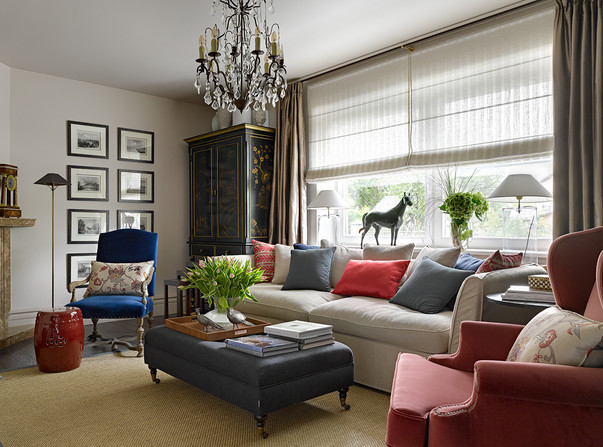
Professional designers know the characteristic features of all styles and can combine them skillfully and in a balanced way.
Let's mix paints
Pure apartment design styles it is almost impossible to meet, our time implies a mixture of directions. Therefore, it is better to take one style as a basis and add elements of other styles to it. So you get a single concept with the addition of various motives. A balanced combination can be achieved by using equal proportions of additional topics. But you shouldn’t get carried away with this either, it’s enough to add one or two additional topics to the main direction. If you create an interior without the help of professionals, you should not use incompatible trends: high-tech and Provence, Japanese style and Art Deco, 1950-60s style and Art Nouveau.
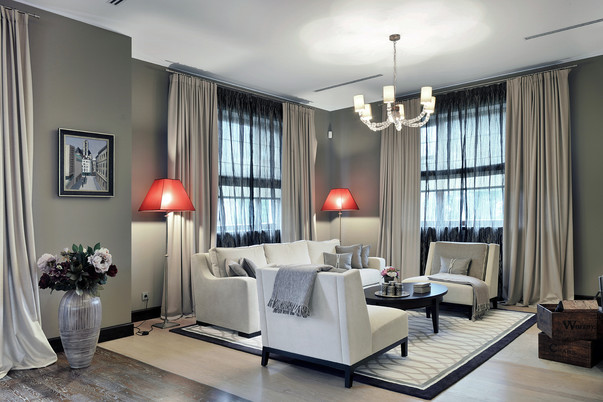
It is important not to overload the interior with objects of complex shapes.
To create an interior in the same style we recommend using the following methods.
- As we said above, choose one foundational style.
- Choose a basic color scheme. It can be several different options:
- one main color with the addition of elements of other colors
- pastel scale
- different shades of the same color.
- In finishing materials, it is better to use textures that combine with each other, which will be in harmony with both the chosen style and the chosen color scheme.

We tried to highlight a few points that may seem categorical, but this is the most correct and simple way to create a single harmonious interior. A professional designer can make eclecticism and kitsch into a single style, but you should not overestimate your strengths. If you decide to choose only one style for yourself, without adding other topics, do not think that it is impossible to make a mistake within one style. "Pure" styles are a thing of the past, so you should not get carried away with too characteristic features of one style, otherwise the interior will look oppressive and overloaded.
- The style of furniture should also be in line with the chosen concept. Most manufacturers divide furniture into two areas: modern and classic. Furniture of simple forms is suitable for modern styles: minimalism, high-tech, Japanese, Scandinavian. Classic furniture can be used for the following areas: classic, art deco, art nouveau, provence.
- Lighting is chosen according to the same principle as furniture. To achieve harmony in the interior, you can use the built-in lighting. This is an absolutely neutral type of lighting, to which you can add one chandelier or floor lamp of your chosen style as an accent.
- Don't get carried away with decor. The decor carries a strong stylistic focus and can break the overall concept of the interior.
Vases, figurines, textiles, even souvenirs must obey common idea and have your place. It is worth considering this when choosing and selecting items by color, material and shape.
